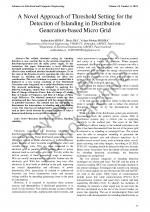| 4/2024 - 4 |
A Novel Approach of Threshold Setting for the Detection of Islanding in Distribution Generation-based Micro GridMISRA, S. |
| Extra paper information in |
| Click to see author's profile in |
| Download PDF |
Author keywords
detection, distribution, generation, islanding, reliability
References keywords
islanding(29), detection(23), power(22), distributed(14), generation(13), technique(6), system(6), distribution(6), synchronous(5), inverter(5)
Blue keywords are present in both the references section and the paper title.
About this article
Date of Publication: 2024-11-30
Volume 24, Issue 4, Year 2024, On page(s): 37 - 46
ISSN: 1582-7445, e-ISSN: 1844-7600
Digital Object Identifier: 10.4316/AECE.2024.04004
Web of Science Accession Number: 001415806000004
SCOPUS ID: 85211380607
Abstract
The reliable threshold setting for islanding detection is now essential due to the growing integration of distributed generators into the utility power supply. In this connection, this paper demonstrates a novel differential threshold methodology to set the detection level that is more effective than traditional absolute threshold techniques. To set the value of the detection level for operating the relay, the two instants i.e. islanding and non-islanding are taken into consideration. This novel technique is a passive method that is deployed to a test system consisting of four Distributed Generation units integrated into a radial distribution network. The proposed methodology is validated by applying five different techniques, namely Rate of Change of Active Power, Rate of Change of Reactive Power, Rate of Change of Voltage, Rate of Change of Frequency, and Rate of Change of Phase Angle Difference. The obtained numerical results are thus promising and have been compared with the numerical values of published literature. The method also has the ability to discriminate the interruptions in islanding and non-islanding events. The relay has not maloperated in non-islanding events such as short circuit whereas the proper operation of relay is demonstrated during severe grid interruptions. |
| References | | | Cited By |
Web of Science® Times Cited: 0
View record in Web of Science® [View]
View Related Records® [View]
Updated 4 days, 2 hours ago
SCOPUS® Times Cited: 0
View record in SCOPUS® [Free preview]
There are no citing papers in the CrossRef Cited-by Linking system.
Disclaimer: All information displayed above was retrieved by using remote connections to respective databases. For the best user experience, we update all data by using background processes, and use caches in order to reduce the load on the servers we retrieve the information from. As we have no control on the availability of the database servers and sometimes the Internet connectivity may be affected, we do not guarantee the information is correct or complete. For the most accurate data, please always consult the database sites directly. Some external links require authentication or an institutional subscription.
Web of Science® is a registered trademark of Clarivate Analytics, Scopus® is a registered trademark of Elsevier B.V., other product names, company names, brand names, trademarks and logos are the property of their respective owners.
Faculty of Electrical Engineering and Computer Science
Stefan cel Mare University of Suceava, Romania
All rights reserved: Advances in Electrical and Computer Engineering is a registered trademark of the Stefan cel Mare University of Suceava. No part of this publication may be reproduced, stored in a retrieval system, photocopied, recorded or archived, without the written permission from the Editor. When authors submit their papers for publication, they agree that the copyright for their article be transferred to the Faculty of Electrical Engineering and Computer Science, Stefan cel Mare University of Suceava, Romania, if and only if the articles are accepted for publication. The copyright covers the exclusive rights to reproduce and distribute the article, including reprints and translations.
Permission for other use: The copyright owner's consent does not extend to copying for general distribution, for promotion, for creating new works, or for resale. Specific written permission must be obtained from the Editor for such copying. Direct linking to files hosted on this website is strictly prohibited.
Disclaimer: Whilst every effort is made by the publishers and editorial board to see that no inaccurate or misleading data, opinions or statements appear in this journal, they wish to make it clear that all information and opinions formulated in the articles, as well as linguistic accuracy, are the sole responsibility of the author.



